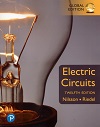

 |
 |
 |
 |
|||||||||||||||||||||||||||||||||||||||||||||||||||||||||||||||||||||||||||||||||||||||||||||||
 |
||||||||||||||||||||||||||||||||||||||||||||||||||||||||||||||||||||||||||||||||||||||||||||||||||
 |
Electric Circuits 12/e Global Edition+作者:
Nilsson+年份:
2024 年12 版
+ISBN:
9781292736198
+書號:
EE0525PC
+規格:
平裝/彩色
+頁數:
800
+出版商:
Pearson(Asia)
+參考資訊:
|
定價
$ |


|
本站購物功能已關閉,點選"購物車"圖示會自動連結到新的購書網頁!或與LINE客服諮詢聯繫
讀者購書請至★滄海書局‧鼎隆圖書購書網 ★https://eshop.tsanghai.com.tw/★
滄海ESHOP購書網提供更方便、快速訂購、結帳付款的購書服務,並提供數位產品購買專區~
書籍若有教學輔助配件,僅提供採用老師教學使用,是非賣品,不販售,亦無法提供一般讀者。
●NEW/UPDATED: 1200 Chapter Problems reinforce problem solving as fundamental to the study of circuit analysis. Nearly all existing problems were revised, and some new problems were added.
●NEW: Assessment Problems let students stop at key points in a chapter and assess their mastery of an objective by applying it to solve 1 or more problems. Every Assessment Problem is new to the 12th Edition and comes with answers to all parts of the problem posed.
●Analysis Methods offer step-by-step directions to guide students to a problem's solution.
●Practical Perspectives introduce real-world circuit examples. Practical applications are demonstrated by performing a quantitative circuit analysis.
●Fundamental Equations and Concepts are set apart to focus on key principles and navigate through important topics.
●Examples illustrate concepts in the form of a numeric example. Nearly 200 examples apply a particular concept, often employ an Analysis Method, and exemplify good problem-solving skills.
●Integration of PSpice and Multisim, popular computer tools for circuit simulation and analysis. Problems suited for exploration with PSpice and Multisim are marked accordingly.
We remember our beloved author, James W. Nilsson, for his lasting legacy to the electrical and computer engineering field. The first edition of Electric Circuits was published in 1983. As this book evolved over the years to better meet the needs of both students and their instructors, the underlying teaching methodologies Jim established remain relevant, even in the 12th Edition. Jim earned his bachelor's degree at the University of Iowa (1948), and his master's degree (1952) and Ph.D. (1958) at Iowa State University. He joined the ISU faculty in 1948 and taught electrical engineering there for 39 years. He became an IEEE fellow in 1990 and earned the prestigious IEEE Undergraduate Teaching Award in 1992.
Professor Susan A. Riedel, emerita, has been a member of the Department of Electrical and Computer Engineering at Marquette University since 1981. She retired in 2012 but continued to teach classes, advise undergraduates and work with graduate students on their research for several years after that. She also held a clinical research appointment in the Department of Orthopaedics at the Medical College of Wisconsin and was a visiting professor in the Bioengineering Unit at the University of Strathclyde, Glasgow, Scotland, as a Fulbright Scholar. She has received many awards for her teaching at Marquette, including the university-wide John P. Raynor SJ Faculty Award for teaching excellence. She has contributed to Electric Circuits since the Third Edition and became solely responsible for the text, supplements, and other supporting materials starting with the Sixth Edition.
1.Circuit Variables
2.Circuit Elements
3.Simple Resistive Circuits
4.Techniques of Circuit Analysis
5.The Operational Amplifier
6.Inductance, Capacitance, and Mutual Inductance
7.Response of First-Order RL and RC Circuits
8.Natural and Step Responses of RLC Circuits
9.Sinusoidal Steady-State Analysis
10.Sinusoidal Steady-State Power Calculations
11.Balanced Three-Phase Circuits
12.Introduction to the Laplace Transform
13.The Laplace Transform in Circuit Analysis
14.Introduction to Frequency Selective Circuits
15.Active Filter Circuits
16.Fourier Series
17.The Fourier Transform
18.Two-Port Circuits
APPENDICES
A.The Solution of Linear Simultaneous Equations
B.Complex Numbers
C.More on Magnetically Coupled Coils and Ideal Transformers
D.The Decibel
E.Bode Diagrams
F.An Abbreviated Table of Trigonometric Identities
G.An Abbreviated Table of Integrals
H.Common Standard Component Values



























